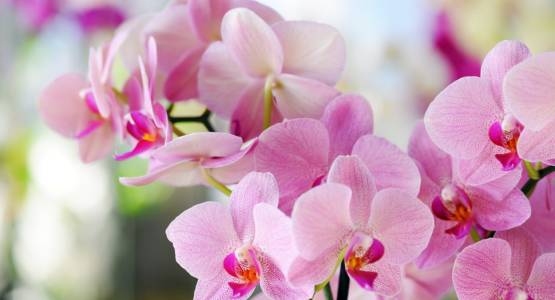Guide to growing orchids in a greenhouse

A Guide to Growing Orchids in a Greenhouse
Growing orchids in a greenhouse allows you to create a controlled environment that caters to their specific needs, ensuring healthy growth and stunning blooms year-round. With thousands of varieties available, orchids can be a rewarding yet challenging plant to cultivate. This guide covers everything from choosing the best varieties and understanding growth stages to positioning your orchids correctly and preventing common mistakes that could lead to their decline.
Choosing the Best Orchid Varieties for a Greenhouse
Not all orchids have the same requirements, so selecting species suited for greenhouse cultivation will make the process easier. Here are some of the best varieties:
- Phalaenopsis (Moth Orchid) – One of the most popular and beginner-friendly orchids. These thrive in indirect light and moderate humidity.
- Cattleya – Known for their large, fragrant blooms, these orchids require bright light and warm conditions.
- Dendrobium – A diverse group, many species in this genus prefer bright light and seasonal watering cycles.

- Vanda – A sun-loving variety that requires high humidity and frequent watering.
- Paphiopedilum (Lady Slipper Orchid) – Prefers shaded conditions and consistent moisture.
By choosing the right variety based on your greenhouse’s conditions, you can set yourself up for success.
Understanding the Growth Stages of Orchids
Orchids go through several distinct growth stages, and understanding these when growing Orchids in a greenhouse can help you provide the right care at the right time.
- Root and Leaf Growth (Vegetative Stage)
- Orchids will focus on developing roots and leaves, absorbing nutrients to establish a strong base.
- Ensure they receive proper light and humidity to encourage growth.
- Flower Spike Formation
- This is when flower spikes begin to develop, usually triggered by slight temperature drops.
- Avoid disturbing the plant too much, as excessive movement can cause flower spikes to abort.
- Blooming Stage
- Once the buds appear, continue with regular watering and avoid drastic environmental changes.
- Some orchids can bloom for weeks or even months.
- Rest Period (Dormancy Stage)
- After blooming, orchids may enter a rest phase where growth slows.
- Reduce watering slightly and avoid over-fertilizing to let the plant recover.
Recognizing these stages ensures that you adjust your care routine accordingly.
Essential Tips for Growing Orchids in a Greenhouse
Temperature Control
Orchids thrive within specific temperature ranges. Most varieties prefer daytime temperatures between 70-85°F (21-29°C) and slightly cooler nights at 55-65°F (13-18°C). A small temperature drop at night encourages flowering in many species.
Humidity Management
Most orchids require humidity levels between 50% and 70%. To maintain this, you can:
- Use a humidifier or mist the plants lightly.
- Place trays of water beneath the plants to increase ambient humidity.
- Ensure good airflow to prevent fungal issues.
Providing the Right Light Levels
Different orchids have varying light requirements:
- Low light: Phalaenopsis and Paphiopedilum thrive in indirect light.
- Medium light: Cattleya and Oncidium prefer filtered or dappled light.
- High light: Vanda and Dendrobium require strong, bright light.
Using shade cloth or adjusting the greenhouse’s positioning can help regulate light exposure.
Watering and Drainage
Overwatering is a common mistake when growing orchids. To prevent this:
- Use a well-draining medium like bark or sphagnum moss.
- Water only when the roots appear silvery-white and dry.
- Avoid letting water collect in the crown of the plant to prevent rot.
Fertilizing Routine
Orchids require nutrients, but excessive feeding can harm them. A balanced fertilizer applied at quarter strength every two weeks during active growth is ideal. During dormancy, reduce feeding to once a month.
Air Circulation
Good airflow prevents mould and strengthens orchid structures. If your greenhouse has poor ventilation:
- Use small fans to keep air moving.
- Space plants out to prevent overcrowding.
- Open vents or doors periodically to allow fresh air circulation.
The Best Positioning for Orchids in a Greenhouse
Correct placement within the greenhouse makes a significant difference in their health.
- East or South-Facing Sections – Best for orchids needing bright but indirect light (e.g., Cattleya, Dendrobium).
- Shaded Areas or Under Shelves – Ideal for low-light orchids like Phalaenopsis and Paphiopedilum.
- Hanging Baskets or Mounts – Good for Vanda orchids that prefer high humidity and good airflow.
- Close to Humidifiers or Misting Areas – Suitable for orchids that need constant moisture.
Grouping orchids with similar light and humidity requirements makes maintenance easier.
How to Avoid Killing Your Orchids
Despite their reputation for being delicate, orchids are resilient when given the right care. Here are common pitfalls and how to avoid them:
- Overwatering – The #1 killer of orchids. Always check the roots before watering.
- Too Much or Too Little Light – Adjust shading or reposition plants as needed.
- Poor Air Circulation – Prevent stagnant air to reduce disease risk.
- Ignoring Seasonal Changes – Adjust temperature and watering habits according to the season.
- Not Repotting When Necessary – Orchids should be repotted every 1-2 years to prevent root rot and maintain a healthy growing medium.
Final Thoughts
Our Guide to growing orchids in a greenhouse provides the advantage of controlled conditions, allowing you to cultivate a variety of species successfully. By choosing the right orchid, understanding its growth stages, and providing proper care in terms of temperature, humidity, lighting, and watering, you can enjoy stunning blooms throughout the year. Avoid common mistakes, and your orchids will thrive, bringing beauty and elegance to your greenhouse for years to come.
